Deciding that it’s time to redesign your website can feel pretty daunting. There are so many things to consider, from integration with your other systems to the look and feel of your website.
It’s important that you get it right, which means searching for a web design company with the experience and expertise you need. But what should you expect to pay for a website, and how can you truly measure the value of a high-performing site?
A great website will support your company in many ways:
- Search visibility: More people can find your site, learn about your company and get their questions answered.
- Accessibility: Your site is accessible and user-friendly for everyone.
- Credibility: A high-quality site helps to gain users’ trust by answering their questions and providing social proof.
- Scalability: Your site can accommodate business expansion and growth.
- Profitability: Your website encourages more people to engage with your site or make purchases.
The bottom line is that a quality website can bring tremendous value to your company.
What is the average cost of a website?
Ah, the age-old question.. “how much is this gonna cost me?”
Generally speaking, a high-performing B2B lead generation site will likely cost around $100k and take about four months to complete. But truthfully, website pricing can vary wildly.
For most companies, website design costs will range from $1,000 working with a small business to $250k+ working with a big web development firm. If you’re currently weighing your options, we’ve broken down some key differences between discount web design and high-end, custom website design.
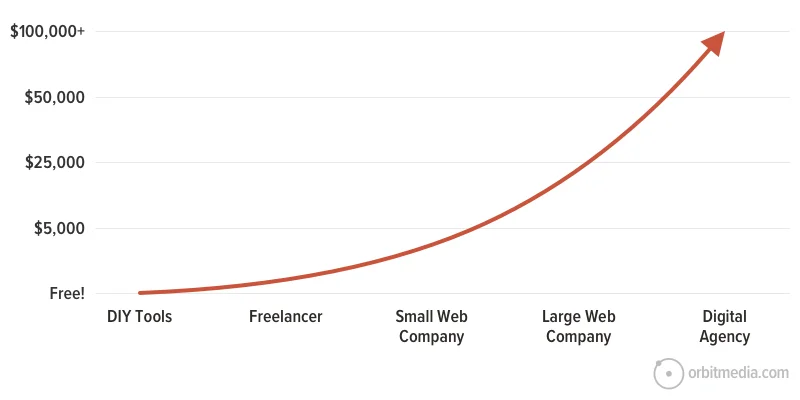
Typically, the majority of a project’s costs are attributed to staff hours: the amount of time and people it takes to create the site.
Total Hours x Hourly Rate = Project Fee
Many factors influence the amount of time (and the amount of money) it will take to create a website. Here are some common factors:
- Project management and communication: Will many people be giving feedback and approvals? Who will manage the project?
- Design: Is the brand well-established or is it being revisited? Is an off-the-shelf template being used?
- Programming: Are the features of the site somewhat standard? Or are they more custom? Does your site include complex features, such as a product catalog, gated content, or resource library?
- Team: Are there a lot of skilled specialists involved? What is their experience level?
- Content: Is it a large site? Is a lot of new writing required? Is there photography or video production needed? The more content there is to create, migrate, or edit often means higher website costs.
- Website maintenance: Will you be maintaining or updating your site on your own? Does your web design agency provide ongoing optimization, web hosting or website maintenance services? Preserving current rankings and search traffic is also vital for the longevity of your site.
As you can see, there is a lot that goes into web design and development. Websites have many requirements, and balancing them takes a thoughtful and strategic approach.
So when you’re shelling out money for a new website, make sure you’re working with an agency that has experience implementing all the features, design, service and strategy you need.
Use our checklist of 10 web design must-haves to ensure you aren’t missing anything.
 |
Chris Gwin, Fractional CFO, MidwestCFO“When planning a website redesign, conduct a cost-benefit analysis. Consider direct and indirect expenses and tangible and intangible benefits. Direct costs include design, development, content creation, and testing. Indirect costs involve internal staff time spent on project management and content migration. Collect historical data, analyze pain points, and research industry benchmarks to estimate benefits accurately. Align your project with strategic objectives to capture all potential benefits.” |
Evaluating website ROI: 5 key factors
So how can you know that your new website is a success? Unfortunately, it can be hard to measure results, especially because certain factors (like search engine optimization) are playing the long game. Though there are a few main factors you can consider when evaluating website ROI:
- The cost of creating the website
As previously mentioned, website cost can vary wildly. The dollars and hours spent during design and development are the baseline for the ROI. - The cost of maintaining the website
Post-launch, out-of-pocket expenses – such as hosting – are probably low. However, ongoing content marketing (blogging, email marketing, social media), and potential advertising costs may be high. ROI Tip: Build a site that will be easy to update. It should never take a web designer or programmer to update content. - The traffic
The number of visitors is the top line for measuring success. If the site is designed to be search engine friendly, the site is far more likely to perform well in search engines. In many cases, a website redesign alone can grow traffic. A sitemap with many pages targeting various phrases and strong content to support those keywords = traffic! - The conversion rate
The percentage of visitors who take action (becoming a lead or purchasing through an ecommerce website) determines the bottom line results. Unlike traffic, it’s the web design, not marketing activity, that has an impact on conversions. But together, traffic times the conversion rate equals results. - The website lifespan
Although car buyers often think ahead about how long they may own the new vehicle, website buyers often do not. But this has a huge impact on the return on investment. Think about it this way- a site that is effective for twice as long has twice the ROI. If you are investing time and money into a highly researched and optimized site, you’ll reap the benefits for a longer period of time.
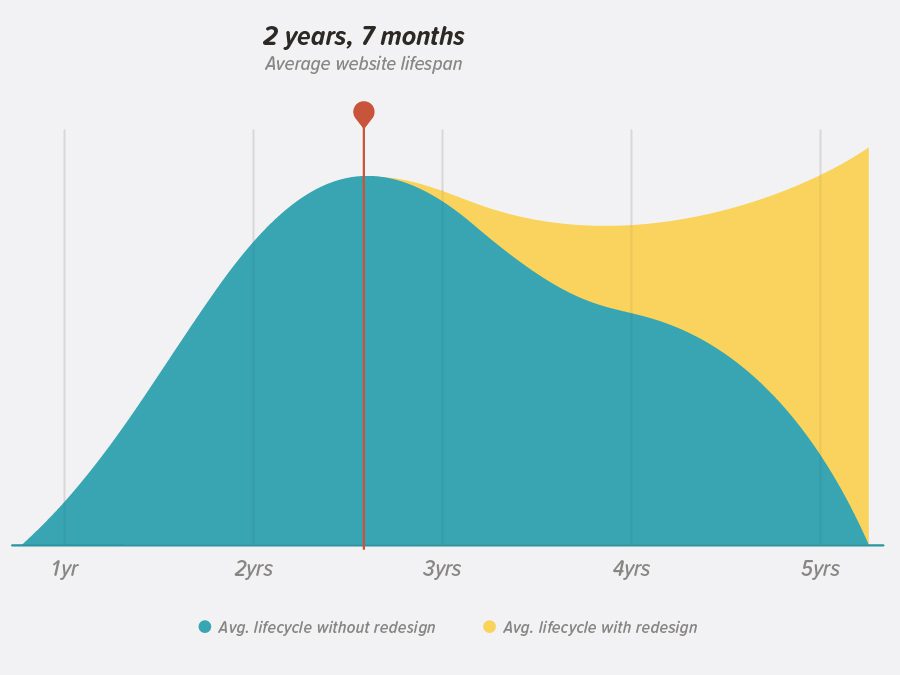
All things being equal, a site that is effective for twice as long has twice the ROI. A great site will produce results for five years or more, especially if you work with an agency that provides ongoing optimizations. On the other hand, a poorly designed site will need a full redesign within two years or less.
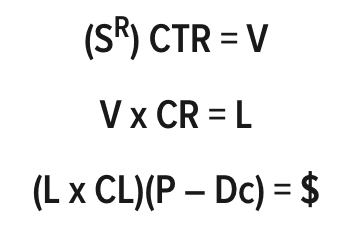
Really want to dig in and calculate website ROI? We suggest a helpful formula in this post for search optimized and lead generation websites.
Website ROI success stories
A well-designed website can greatly contribute to business growth. From direct increases in revenue to an increase in site traffic, investing time and effort into your site can fuel success. Here are a few examples of growth following a website redesign:
- Budderfly, an energy management services company, saw an 18% increase in organic traffic and 28% increase in click-through rate (CTR).
- Vienna Beef’s website traffic tripled after refreshing their site redesign.
- IT support company Applied Tech saw a 33.75% increase in organic traffic and 37% increase in ranked pages on Google.
- Plum Diamonds saw over 100% increase in organic search engaged sessions and a 700% increase in sales following website optimization.
Assessing website value
Increased conversions and search traffic don’t happen on their own. Many other elements of your site play an important role when evaluating the value of your website.
User experience and user interface
Designing a website that is easy to navigate will drive engagement and keep users happy. When a user has a positive experience on your website, they are more likely to stick around, potentially leading to increased conversions.
Traffic and SEO
While website design alone can play a big role in search traffic, making a conscious effort to involve SEO strategy can make a world of difference.
- Are you targeting important keywords?
- Have you followed the SEO basics to improve your rankings?
- What is your domain authority?
An SEO web agency will take all of these things into consideration when creating your website. A good SEO strategy now can benefit you for months (maybe even years) to come.
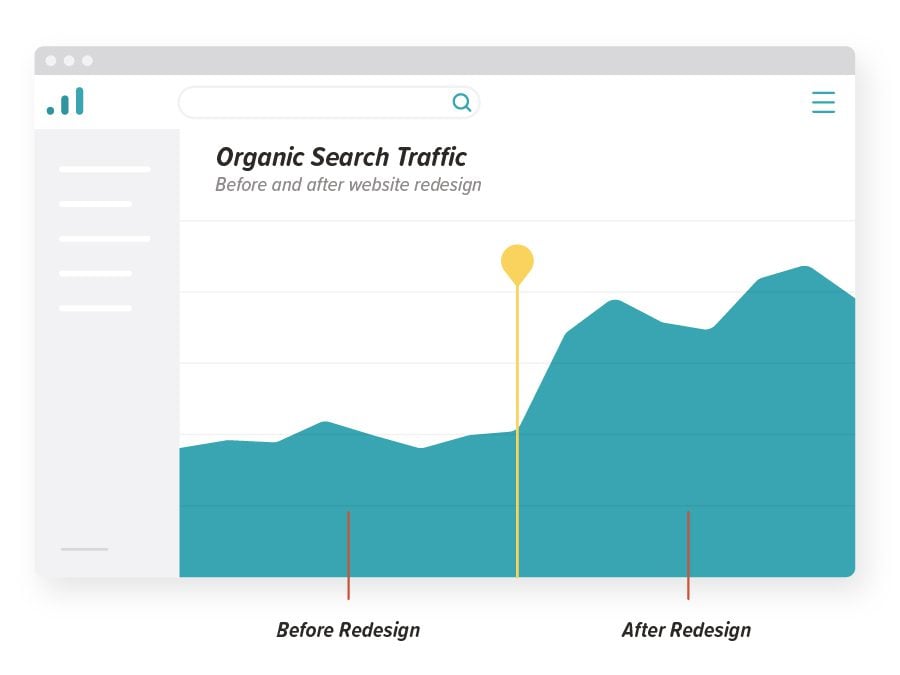
Brand awareness and credibility
A high-quality website speaks volumes about your brand. If a client is seriously considering purchasing with you, only to find an outdated or confusing site, they may second guess their decision. On the other hand, a well-designed site with social proof, testimonials and easy-to-find information can encourage them to seal the deal.
Long-term investment
Although a new website can be a high-budget project, it is a long-term investment that can bring in a lot of value, either in direct revenue from ecommerce sites or increased leads for a lead generation website. Websites serve as advertisement and marketing tools, and when designed and developed well, can easily be updated and maintained for years to come.
Analyzing your audience and competitors
Your website (when you have analytics properly set up) is an incredible tool for helping you assess your competitors and audience. Using tools like Google Analytics, Semrush, Google Search Console and others, gives you insight into what your audience is searching for, how they interact with your website and what your competitors are doing right or wrong. Just make sure you have your site set up properly to collect this data and work with an agency that has experience in analytics.
What to prioritize when looking for a web design company
Now that you have a better idea of what a new website might cost and all the value it can bring, how can you pick a good web design company?
A comprehensive web design partner will have expertise in a few different areas:
- Analytics
Data is key for putting together a high-performing website. Understanding user journeys, analyzing competitors and knowing how to set up your website for data collection and analysis will help you in the long term. - SEO
A search-driven redesign strategy will consider technical, on-page and off-page SEO and focus on preserving existing rankings and aiming for new opportunities. - Conversions
Not only is traffic to your site important, but using persuasive language to get users to convert is essential. Conversion-oriented brand storytelling can effectively tell your story and encourage users to move forward with your company. - Full-time support
A website includes many ongoing and moving parts. Without dedicated, full-time support, there are hidden risks. A true full-time partner will include a dedicated support team that is entirely focused on launched sites. This means you receive constant support for the hosting, maintenance and optimization of your website at all times. - Partnership and values
Aside from putting together a good site and supporting you in the long term, you want to work with a company that shares your values and inspiration. - Accessibility knowledge
A comprehensive web design partner will ensure your site is accessible for all people to use, ensuring compliance with Section 508 and WCAG guidelines. - Project timeline
Be sure to ask about potential timelines and project communication strategy to ensure your website will be completed on time and on budget. - Digital marketing
A strong understanding of how websites support and blend with digital marketing initiatives, including email, social, content strategy, PPC, offline marketing, etc… - Experience, testimonials and proof
Any credible web design agency will have evidence of their work easily accessible. Look for testimonials, case studies and reviews from happy clients. Another good sign is when a team has years of experience working together.
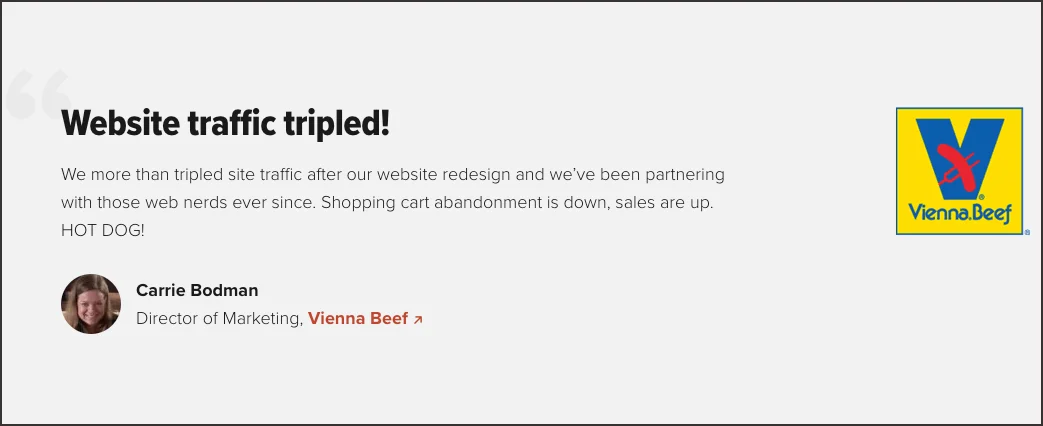
The bottom line is to find a partner that is knowledgeable and reliable. Review the proposal details, research the company and then make your decision. Get more tips on how to avoid common mistakes when buying a website.
Addressing common roadblocks
It’s not always easy to commit to a high-budget project, especially when key stakeholders have concerns about budgeting and other factors. Here are some common roadblocks or concerns and how you can overcome them.
Budgeting
Money talk is rarely ever fun, but it is important for internal stakeholders and your design agency to be aligned on budget expectations. Ask yourself what you’re comfortable spending, and speak to a few agencies to get a feel for what your budget can realistically get you. Once you align your budget and your expectations, you’ll always be happy!
Some things to keep in mind:
- Some agencies may offer basic website design options for a lower cost over customized design or premium theme options
- Leveraging your staff’s abilities: Do you have a copywriter or content entry specialist on staff? Anyone who can take some work off of the design agency? You could potentially save money by doing some of this work yourself.
Knowledge gaps
If you don’t know much about SEO, analytics, web design, website development, accessibility, or any of the many factors that go into a website, it may seem overwhelming or confusing to plan your redesign. It can be hard to put all of your trust (and money) into something you don’t feel very knowledgeable about.
This is why a long-term partner is so important. A comprehensive agency will be in it for the long run, and should even be able to teach you some of the basics when it comes to setting up analytics, updating your content and more.
Commitment
Everyone knows somebody who’s scared of commitment… right?
Whether professionally or otherwise, commitment can be scary.
- What if you don’t get along with the team the way you thought you would?
- What if your vision changes down the line?
- What if the new website doesn’t perform, or your site loses traffic after launch?
These are all valid concerns, which is why it’s important to get an understanding of who you’ll be working with before signing a contract.
Will your staff be trained properly so that you can make changes yourself down the road? What is the agency’s protocol for making edits or optimizations in the future? While it can seem intimidating, a long-term partner is a must. You want an agency that will support you for months or years after launch. Just make sure to ask some of these important questions before anything is official.
Orbit offers managed website and web hosting services as well as optimization services to ensure your website stays secure, search-optimized and up-to-date.
Investing in your website can have powerful results
Your website is your most visible asset. It’s vital that your site accurately reflects your company while keeping UX, accessibility, SEO and scalability in mind.
It can be daunting to see the price tag that comes with a new website but keep in mind that a well-designed site brings a lot of value to your company. Whether you’re measuring value through ROI or factors such as brand awareness, credibility, UX and SEO, you’re bound to see some positive results.
Orbit has over 20 years of experience and has developed over 1,000+ websites for companies in every industry. Orbit sites are focused on beautiful design, research-driven strategy and conversion optimization, all while prioritizing pricing transparency.
In addition to designing high-performing websites, Orbit is a long-term support partner, offering:
- Post-launch website optimization
- Website performance assessments
- A/B testing and measurement of implemented changes
- Managed website and shared hosting services
Ready to take the next step? Schedule a call with a digital strategist →




